Research Proposal: Strategy Execution in Abu Dhabi
VerifiedAdded on 2022/11/13
|14
|3496
|118
Project
AI Summary
This research proposal investigates strategy execution processes within the Abu Dhabi Executive Office (ADEO), focusing on the transition from strategy formalization to service delivery. The study aims to identify challenges ADEO faces in efficiently delivering services and to propose improvements. The research will employ a descriptive research design, utilizing an interpretivism philosophy and an inductive research approach. A case study strategy will be used, with ADEO as the focal organization. The methodology includes qualitative data collection to explore strategy formalization, execution processes, and service delivery challenges. The literature review covers key concepts such as strategy formalization, execution, and the importance of organizational alignment. The proposal highlights the significance of the study in understanding the challenges of strategy implementation in a governmental context and offers insights for enhancing service delivery. The research will use case study to analyze the challenges faced by ADEO and suggest improvements.
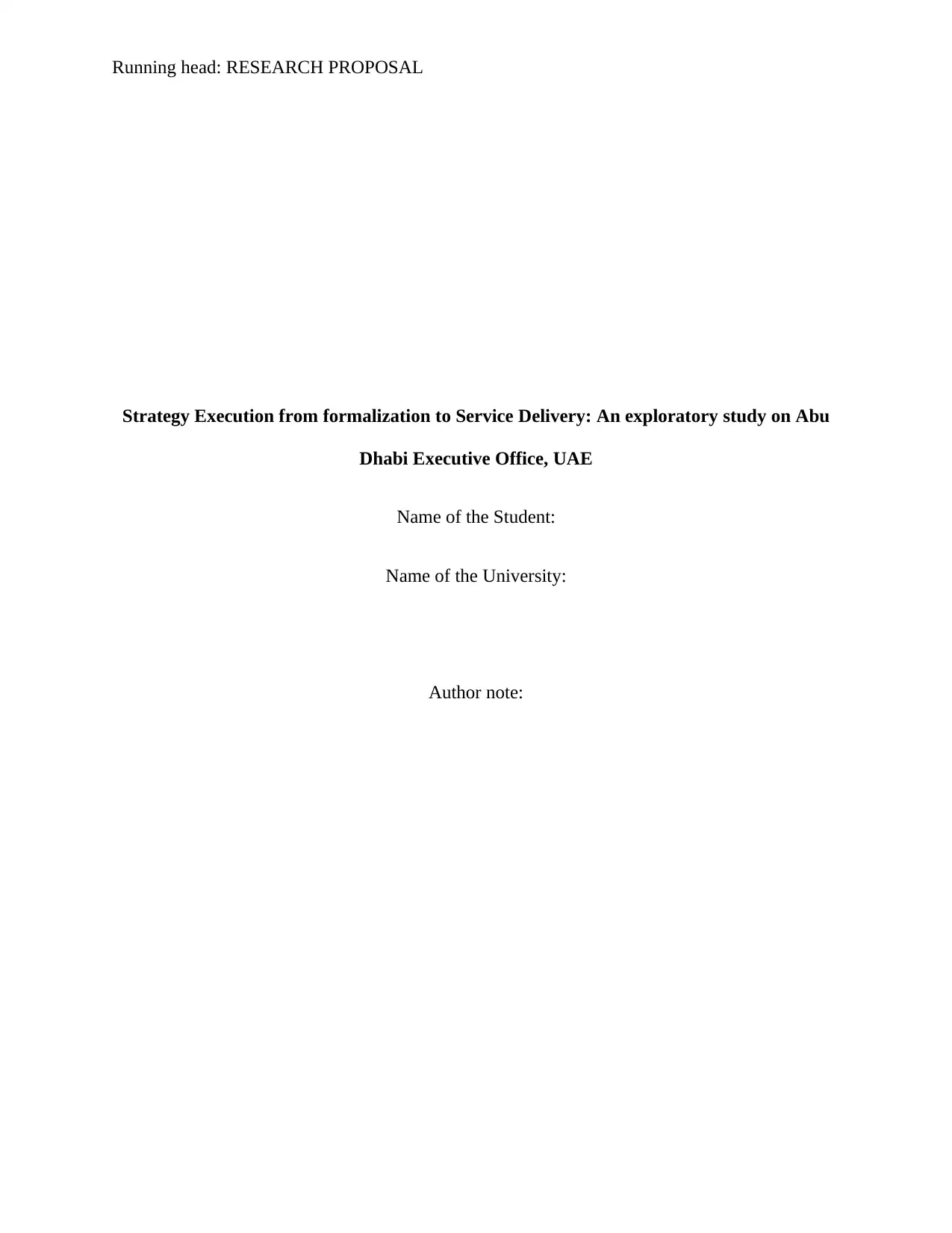
Running head: RESEARCH PROPOSAL
Strategy Execution from formalization to Service Delivery: An exploratory study on Abu
Dhabi Executive Office, UAE
Name of the Student:
Name of the University:
Author note:
Strategy Execution from formalization to Service Delivery: An exploratory study on Abu
Dhabi Executive Office, UAE
Name of the Student:
Name of the University:
Author note:
Paraphrase This Document
Need a fresh take? Get an instant paraphrase of this document with our AI Paraphraser
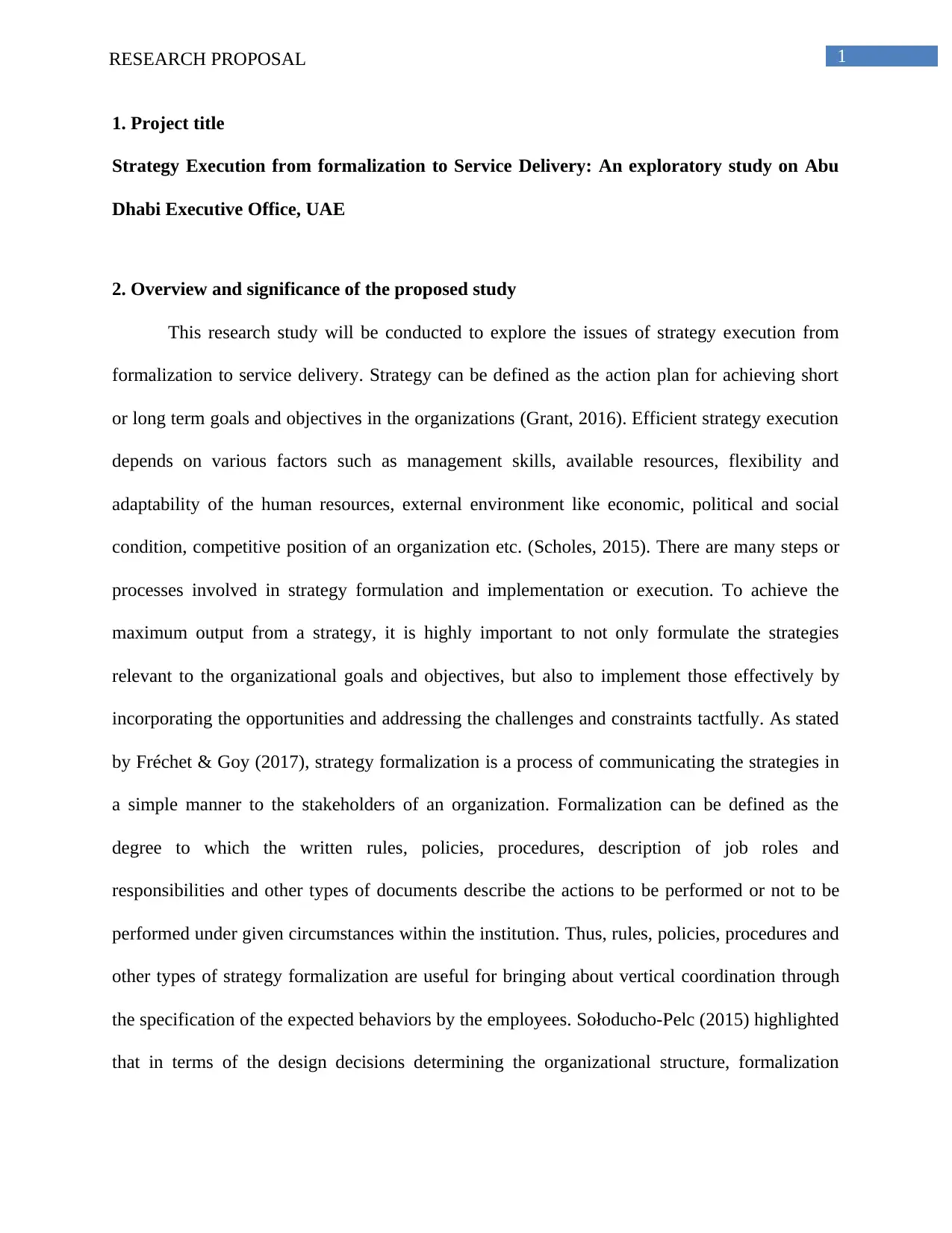
1RESEARCH PROPOSAL
1. Project title
Strategy Execution from formalization to Service Delivery: An exploratory study on Abu
Dhabi Executive Office, UAE
2. Overview and significance of the proposed study
This research study will be conducted to explore the issues of strategy execution from
formalization to service delivery. Strategy can be defined as the action plan for achieving short
or long term goals and objectives in the organizations (Grant, 2016). Efficient strategy execution
depends on various factors such as management skills, available resources, flexibility and
adaptability of the human resources, external environment like economic, political and social
condition, competitive position of an organization etc. (Scholes, 2015). There are many steps or
processes involved in strategy formulation and implementation or execution. To achieve the
maximum output from a strategy, it is highly important to not only formulate the strategies
relevant to the organizational goals and objectives, but also to implement those effectively by
incorporating the opportunities and addressing the challenges and constraints tactfully. As stated
by Fréchet & Goy (2017), strategy formalization is a process of communicating the strategies in
a simple manner to the stakeholders of an organization. Formalization can be defined as the
degree to which the written rules, policies, procedures, description of job roles and
responsibilities and other types of documents describe the actions to be performed or not to be
performed under given circumstances within the institution. Thus, rules, policies, procedures and
other types of strategy formalization are useful for bringing about vertical coordination through
the specification of the expected behaviors by the employees. Sołoducho-Pelc (2015) highlighted
that in terms of the design decisions determining the organizational structure, formalization
1. Project title
Strategy Execution from formalization to Service Delivery: An exploratory study on Abu
Dhabi Executive Office, UAE
2. Overview and significance of the proposed study
This research study will be conducted to explore the issues of strategy execution from
formalization to service delivery. Strategy can be defined as the action plan for achieving short
or long term goals and objectives in the organizations (Grant, 2016). Efficient strategy execution
depends on various factors such as management skills, available resources, flexibility and
adaptability of the human resources, external environment like economic, political and social
condition, competitive position of an organization etc. (Scholes, 2015). There are many steps or
processes involved in strategy formulation and implementation or execution. To achieve the
maximum output from a strategy, it is highly important to not only formulate the strategies
relevant to the organizational goals and objectives, but also to implement those effectively by
incorporating the opportunities and addressing the challenges and constraints tactfully. As stated
by Fréchet & Goy (2017), strategy formalization is a process of communicating the strategies in
a simple manner to the stakeholders of an organization. Formalization can be defined as the
degree to which the written rules, policies, procedures, description of job roles and
responsibilities and other types of documents describe the actions to be performed or not to be
performed under given circumstances within the institution. Thus, rules, policies, procedures and
other types of strategy formalization are useful for bringing about vertical coordination through
the specification of the expected behaviors by the employees. Sołoducho-Pelc (2015) highlighted
that in terms of the design decisions determining the organizational structure, formalization
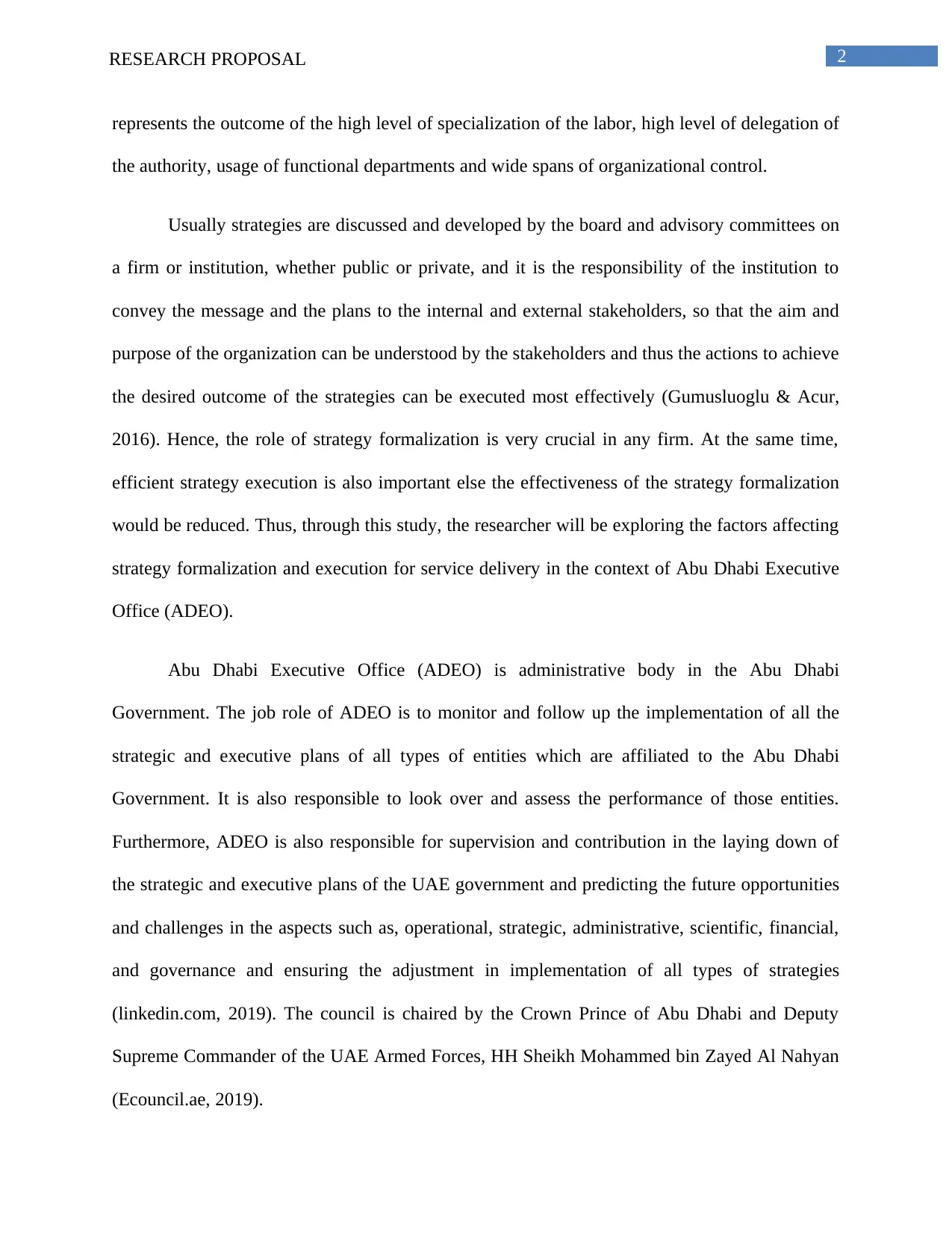
2RESEARCH PROPOSAL
represents the outcome of the high level of specialization of the labor, high level of delegation of
the authority, usage of functional departments and wide spans of organizational control.
Usually strategies are discussed and developed by the board and advisory committees on
a firm or institution, whether public or private, and it is the responsibility of the institution to
convey the message and the plans to the internal and external stakeholders, so that the aim and
purpose of the organization can be understood by the stakeholders and thus the actions to achieve
the desired outcome of the strategies can be executed most effectively (Gumusluoglu & Acur,
2016). Hence, the role of strategy formalization is very crucial in any firm. At the same time,
efficient strategy execution is also important else the effectiveness of the strategy formalization
would be reduced. Thus, through this study, the researcher will be exploring the factors affecting
strategy formalization and execution for service delivery in the context of Abu Dhabi Executive
Office (ADEO).
Abu Dhabi Executive Office (ADEO) is administrative body in the Abu Dhabi
Government. The job role of ADEO is to monitor and follow up the implementation of all the
strategic and executive plans of all types of entities which are affiliated to the Abu Dhabi
Government. It is also responsible to look over and assess the performance of those entities.
Furthermore, ADEO is also responsible for supervision and contribution in the laying down of
the strategic and executive plans of the UAE government and predicting the future opportunities
and challenges in the aspects such as, operational, strategic, administrative, scientific, financial,
and governance and ensuring the adjustment in implementation of all types of strategies
(linkedin.com, 2019). The council is chaired by the Crown Prince of Abu Dhabi and Deputy
Supreme Commander of the UAE Armed Forces, HH Sheikh Mohammed bin Zayed Al Nahyan
(Ecouncil.ae, 2019).
represents the outcome of the high level of specialization of the labor, high level of delegation of
the authority, usage of functional departments and wide spans of organizational control.
Usually strategies are discussed and developed by the board and advisory committees on
a firm or institution, whether public or private, and it is the responsibility of the institution to
convey the message and the plans to the internal and external stakeholders, so that the aim and
purpose of the organization can be understood by the stakeholders and thus the actions to achieve
the desired outcome of the strategies can be executed most effectively (Gumusluoglu & Acur,
2016). Hence, the role of strategy formalization is very crucial in any firm. At the same time,
efficient strategy execution is also important else the effectiveness of the strategy formalization
would be reduced. Thus, through this study, the researcher will be exploring the factors affecting
strategy formalization and execution for service delivery in the context of Abu Dhabi Executive
Office (ADEO).
Abu Dhabi Executive Office (ADEO) is administrative body in the Abu Dhabi
Government. The job role of ADEO is to monitor and follow up the implementation of all the
strategic and executive plans of all types of entities which are affiliated to the Abu Dhabi
Government. It is also responsible to look over and assess the performance of those entities.
Furthermore, ADEO is also responsible for supervision and contribution in the laying down of
the strategic and executive plans of the UAE government and predicting the future opportunities
and challenges in the aspects such as, operational, strategic, administrative, scientific, financial,
and governance and ensuring the adjustment in implementation of all types of strategies
(linkedin.com, 2019). The council is chaired by the Crown Prince of Abu Dhabi and Deputy
Supreme Commander of the UAE Armed Forces, HH Sheikh Mohammed bin Zayed Al Nahyan
(Ecouncil.ae, 2019).
⊘ This is a preview!⊘
Do you want full access?
Subscribe today to unlock all pages.

Trusted by 1+ million students worldwide
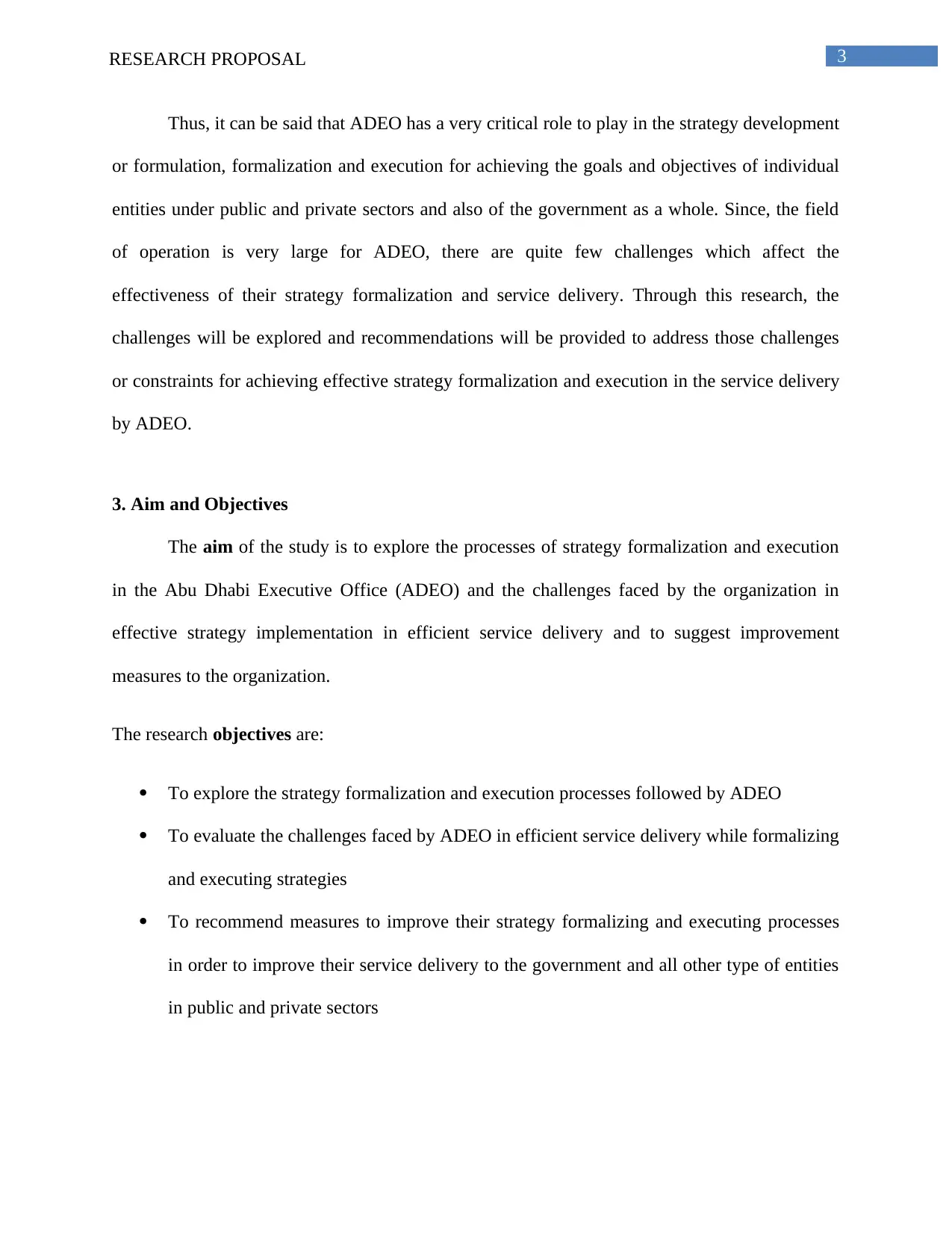
3RESEARCH PROPOSAL
Thus, it can be said that ADEO has a very critical role to play in the strategy development
or formulation, formalization and execution for achieving the goals and objectives of individual
entities under public and private sectors and also of the government as a whole. Since, the field
of operation is very large for ADEO, there are quite few challenges which affect the
effectiveness of their strategy formalization and service delivery. Through this research, the
challenges will be explored and recommendations will be provided to address those challenges
or constraints for achieving effective strategy formalization and execution in the service delivery
by ADEO.
3. Aim and Objectives
The aim of the study is to explore the processes of strategy formalization and execution
in the Abu Dhabi Executive Office (ADEO) and the challenges faced by the organization in
effective strategy implementation in efficient service delivery and to suggest improvement
measures to the organization.
The research objectives are:
To explore the strategy formalization and execution processes followed by ADEO
To evaluate the challenges faced by ADEO in efficient service delivery while formalizing
and executing strategies
To recommend measures to improve their strategy formalizing and executing processes
in order to improve their service delivery to the government and all other type of entities
in public and private sectors
Thus, it can be said that ADEO has a very critical role to play in the strategy development
or formulation, formalization and execution for achieving the goals and objectives of individual
entities under public and private sectors and also of the government as a whole. Since, the field
of operation is very large for ADEO, there are quite few challenges which affect the
effectiveness of their strategy formalization and service delivery. Through this research, the
challenges will be explored and recommendations will be provided to address those challenges
or constraints for achieving effective strategy formalization and execution in the service delivery
by ADEO.
3. Aim and Objectives
The aim of the study is to explore the processes of strategy formalization and execution
in the Abu Dhabi Executive Office (ADEO) and the challenges faced by the organization in
effective strategy implementation in efficient service delivery and to suggest improvement
measures to the organization.
The research objectives are:
To explore the strategy formalization and execution processes followed by ADEO
To evaluate the challenges faced by ADEO in efficient service delivery while formalizing
and executing strategies
To recommend measures to improve their strategy formalizing and executing processes
in order to improve their service delivery to the government and all other type of entities
in public and private sectors
Paraphrase This Document
Need a fresh take? Get an instant paraphrase of this document with our AI Paraphraser
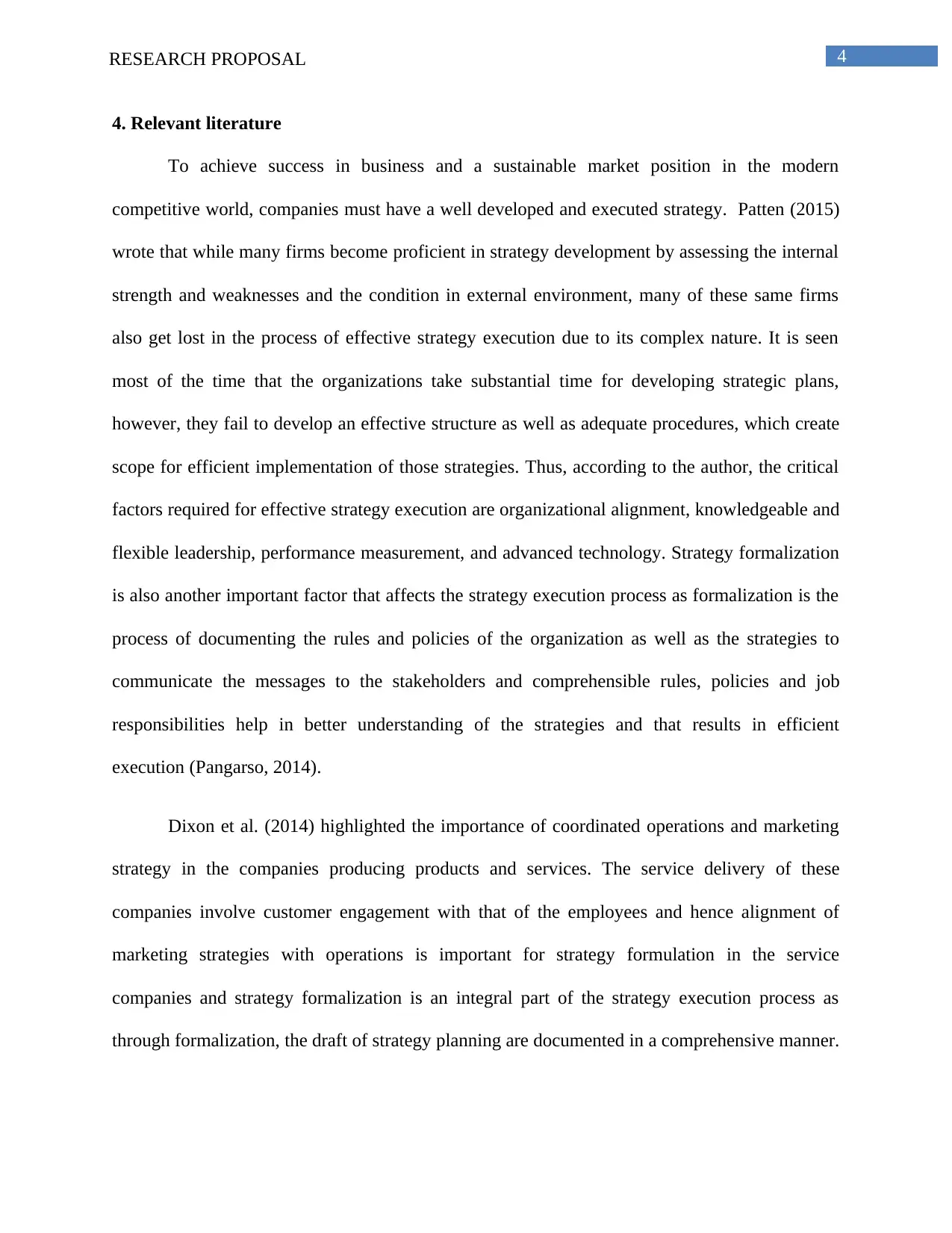
4RESEARCH PROPOSAL
4. Relevant literature
To achieve success in business and a sustainable market position in the modern
competitive world, companies must have a well developed and executed strategy. Patten (2015)
wrote that while many firms become proficient in strategy development by assessing the internal
strength and weaknesses and the condition in external environment, many of these same firms
also get lost in the process of effective strategy execution due to its complex nature. It is seen
most of the time that the organizations take substantial time for developing strategic plans,
however, they fail to develop an effective structure as well as adequate procedures, which create
scope for efficient implementation of those strategies. Thus, according to the author, the critical
factors required for effective strategy execution are organizational alignment, knowledgeable and
flexible leadership, performance measurement, and advanced technology. Strategy formalization
is also another important factor that affects the strategy execution process as formalization is the
process of documenting the rules and policies of the organization as well as the strategies to
communicate the messages to the stakeholders and comprehensible rules, policies and job
responsibilities help in better understanding of the strategies and that results in efficient
execution (Pangarso, 2014).
Dixon et al. (2014) highlighted the importance of coordinated operations and marketing
strategy in the companies producing products and services. The service delivery of these
companies involve customer engagement with that of the employees and hence alignment of
marketing strategies with operations is important for strategy formulation in the service
companies and strategy formalization is an integral part of the strategy execution process as
through formalization, the draft of strategy planning are documented in a comprehensive manner.
4. Relevant literature
To achieve success in business and a sustainable market position in the modern
competitive world, companies must have a well developed and executed strategy. Patten (2015)
wrote that while many firms become proficient in strategy development by assessing the internal
strength and weaknesses and the condition in external environment, many of these same firms
also get lost in the process of effective strategy execution due to its complex nature. It is seen
most of the time that the organizations take substantial time for developing strategic plans,
however, they fail to develop an effective structure as well as adequate procedures, which create
scope for efficient implementation of those strategies. Thus, according to the author, the critical
factors required for effective strategy execution are organizational alignment, knowledgeable and
flexible leadership, performance measurement, and advanced technology. Strategy formalization
is also another important factor that affects the strategy execution process as formalization is the
process of documenting the rules and policies of the organization as well as the strategies to
communicate the messages to the stakeholders and comprehensible rules, policies and job
responsibilities help in better understanding of the strategies and that results in efficient
execution (Pangarso, 2014).
Dixon et al. (2014) highlighted the importance of coordinated operations and marketing
strategy in the companies producing products and services. The service delivery of these
companies involve customer engagement with that of the employees and hence alignment of
marketing strategies with operations is important for strategy formulation in the service
companies and strategy formalization is an integral part of the strategy execution process as
through formalization, the draft of strategy planning are documented in a comprehensive manner.
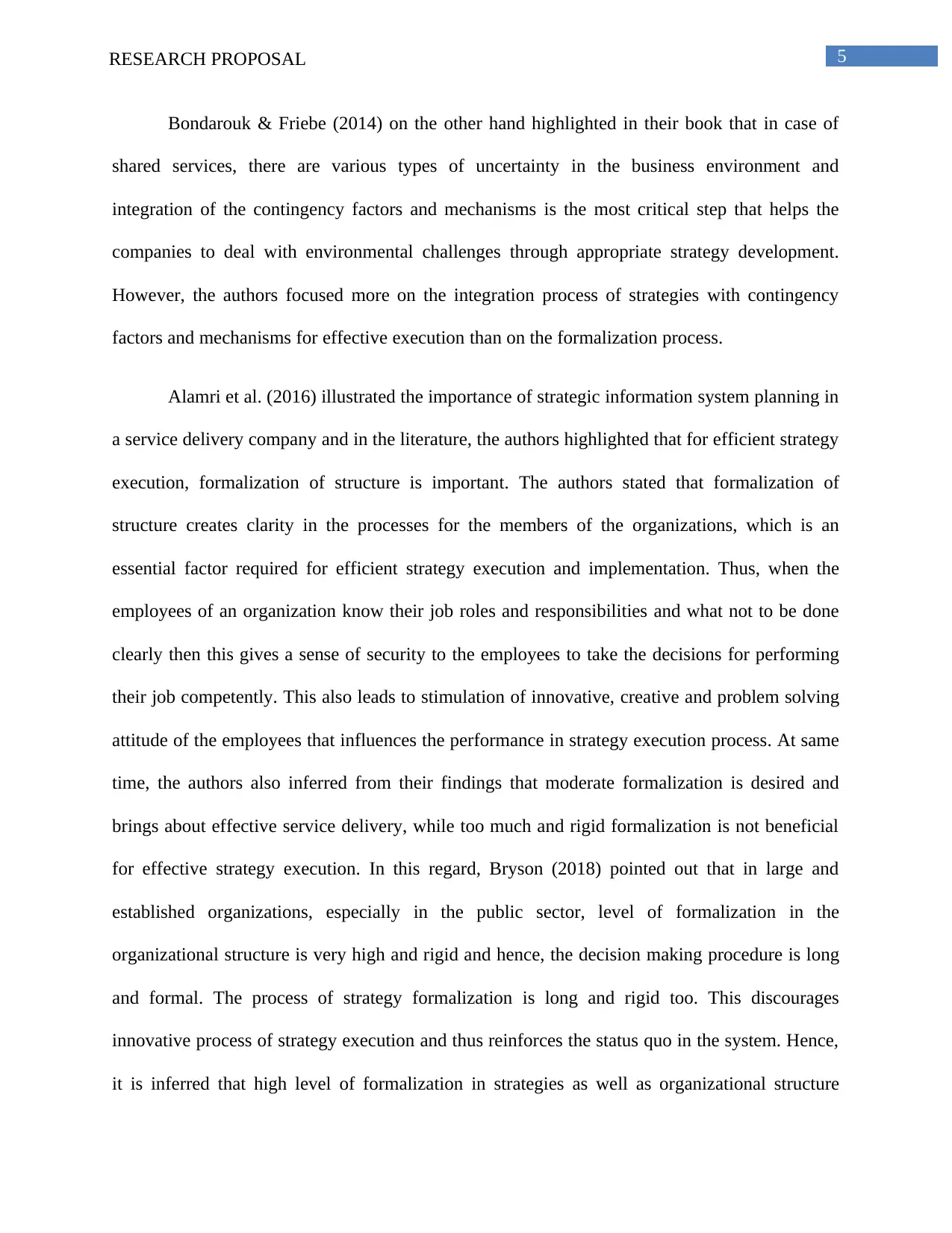
5RESEARCH PROPOSAL
Bondarouk & Friebe (2014) on the other hand highlighted in their book that in case of
shared services, there are various types of uncertainty in the business environment and
integration of the contingency factors and mechanisms is the most critical step that helps the
companies to deal with environmental challenges through appropriate strategy development.
However, the authors focused more on the integration process of strategies with contingency
factors and mechanisms for effective execution than on the formalization process.
Alamri et al. (2016) illustrated the importance of strategic information system planning in
a service delivery company and in the literature, the authors highlighted that for efficient strategy
execution, formalization of structure is important. The authors stated that formalization of
structure creates clarity in the processes for the members of the organizations, which is an
essential factor required for efficient strategy execution and implementation. Thus, when the
employees of an organization know their job roles and responsibilities and what not to be done
clearly then this gives a sense of security to the employees to take the decisions for performing
their job competently. This also leads to stimulation of innovative, creative and problem solving
attitude of the employees that influences the performance in strategy execution process. At same
time, the authors also inferred from their findings that moderate formalization is desired and
brings about effective service delivery, while too much and rigid formalization is not beneficial
for effective strategy execution. In this regard, Bryson (2018) pointed out that in large and
established organizations, especially in the public sector, level of formalization in the
organizational structure is very high and rigid and hence, the decision making procedure is long
and formal. The process of strategy formalization is long and rigid too. This discourages
innovative process of strategy execution and thus reinforces the status quo in the system. Hence,
it is inferred that high level of formalization in strategies as well as organizational structure
Bondarouk & Friebe (2014) on the other hand highlighted in their book that in case of
shared services, there are various types of uncertainty in the business environment and
integration of the contingency factors and mechanisms is the most critical step that helps the
companies to deal with environmental challenges through appropriate strategy development.
However, the authors focused more on the integration process of strategies with contingency
factors and mechanisms for effective execution than on the formalization process.
Alamri et al. (2016) illustrated the importance of strategic information system planning in
a service delivery company and in the literature, the authors highlighted that for efficient strategy
execution, formalization of structure is important. The authors stated that formalization of
structure creates clarity in the processes for the members of the organizations, which is an
essential factor required for efficient strategy execution and implementation. Thus, when the
employees of an organization know their job roles and responsibilities and what not to be done
clearly then this gives a sense of security to the employees to take the decisions for performing
their job competently. This also leads to stimulation of innovative, creative and problem solving
attitude of the employees that influences the performance in strategy execution process. At same
time, the authors also inferred from their findings that moderate formalization is desired and
brings about effective service delivery, while too much and rigid formalization is not beneficial
for effective strategy execution. In this regard, Bryson (2018) pointed out that in large and
established organizations, especially in the public sector, level of formalization in the
organizational structure is very high and rigid and hence, the decision making procedure is long
and formal. The process of strategy formalization is long and rigid too. This discourages
innovative process of strategy execution and thus reinforces the status quo in the system. Hence,
it is inferred that high level of formalization in strategies as well as organizational structure
⊘ This is a preview!⊘
Do you want full access?
Subscribe today to unlock all pages.

Trusted by 1+ million students worldwide
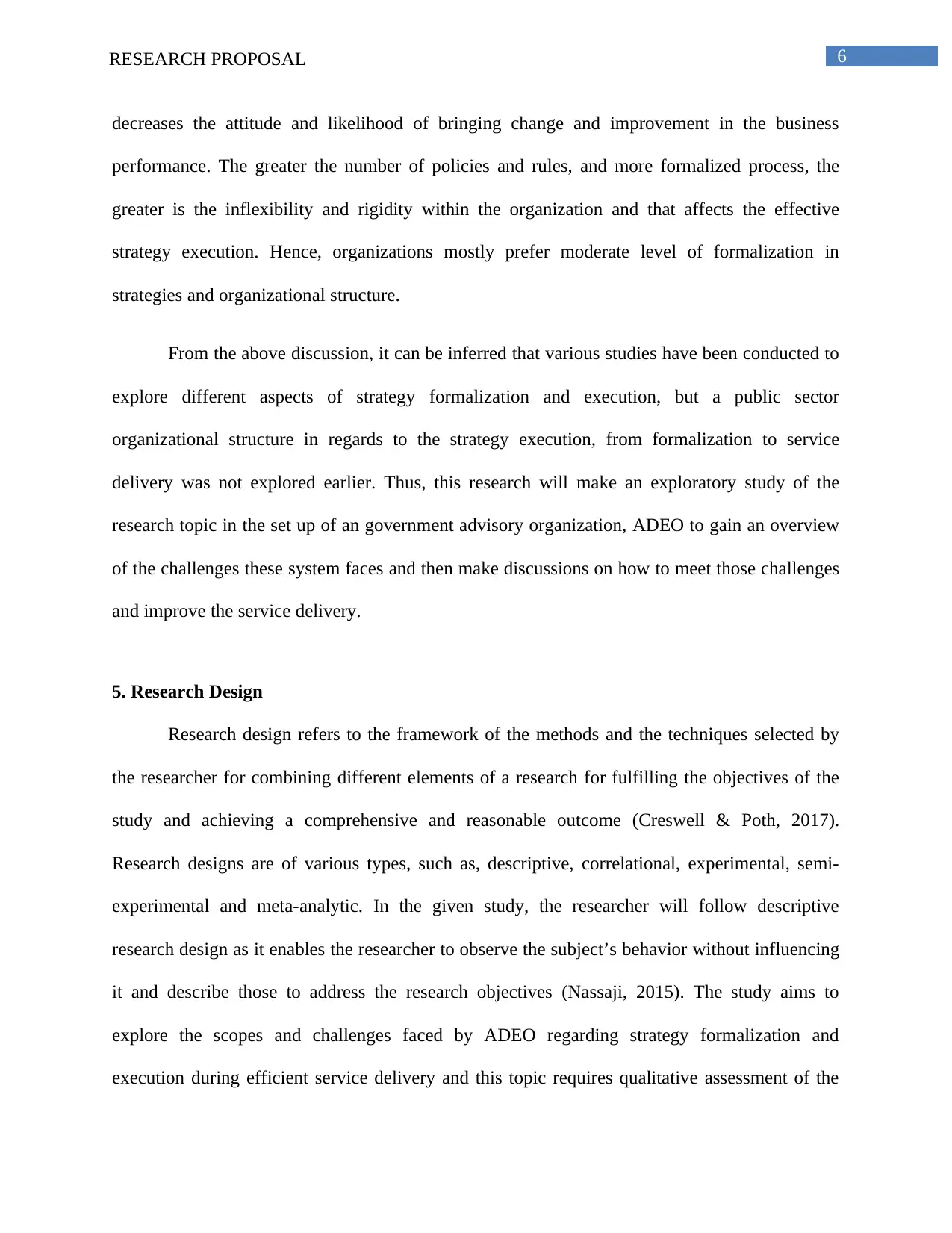
6RESEARCH PROPOSAL
decreases the attitude and likelihood of bringing change and improvement in the business
performance. The greater the number of policies and rules, and more formalized process, the
greater is the inflexibility and rigidity within the organization and that affects the effective
strategy execution. Hence, organizations mostly prefer moderate level of formalization in
strategies and organizational structure.
From the above discussion, it can be inferred that various studies have been conducted to
explore different aspects of strategy formalization and execution, but a public sector
organizational structure in regards to the strategy execution, from formalization to service
delivery was not explored earlier. Thus, this research will make an exploratory study of the
research topic in the set up of an government advisory organization, ADEO to gain an overview
of the challenges these system faces and then make discussions on how to meet those challenges
and improve the service delivery.
5. Research Design
Research design refers to the framework of the methods and the techniques selected by
the researcher for combining different elements of a research for fulfilling the objectives of the
study and achieving a comprehensive and reasonable outcome (Creswell & Poth, 2017).
Research designs are of various types, such as, descriptive, correlational, experimental, semi-
experimental and meta-analytic. In the given study, the researcher will follow descriptive
research design as it enables the researcher to observe the subject’s behavior without influencing
it and describe those to address the research objectives (Nassaji, 2015). The study aims to
explore the scopes and challenges faced by ADEO regarding strategy formalization and
execution during efficient service delivery and this topic requires qualitative assessment of the
decreases the attitude and likelihood of bringing change and improvement in the business
performance. The greater the number of policies and rules, and more formalized process, the
greater is the inflexibility and rigidity within the organization and that affects the effective
strategy execution. Hence, organizations mostly prefer moderate level of formalization in
strategies and organizational structure.
From the above discussion, it can be inferred that various studies have been conducted to
explore different aspects of strategy formalization and execution, but a public sector
organizational structure in regards to the strategy execution, from formalization to service
delivery was not explored earlier. Thus, this research will make an exploratory study of the
research topic in the set up of an government advisory organization, ADEO to gain an overview
of the challenges these system faces and then make discussions on how to meet those challenges
and improve the service delivery.
5. Research Design
Research design refers to the framework of the methods and the techniques selected by
the researcher for combining different elements of a research for fulfilling the objectives of the
study and achieving a comprehensive and reasonable outcome (Creswell & Poth, 2017).
Research designs are of various types, such as, descriptive, correlational, experimental, semi-
experimental and meta-analytic. In the given study, the researcher will follow descriptive
research design as it enables the researcher to observe the subject’s behavior without influencing
it and describe those to address the research objectives (Nassaji, 2015). The study aims to
explore the scopes and challenges faced by ADEO regarding strategy formalization and
execution during efficient service delivery and this topic requires qualitative assessment of the
Paraphrase This Document
Need a fresh take? Get an instant paraphrase of this document with our AI Paraphraser
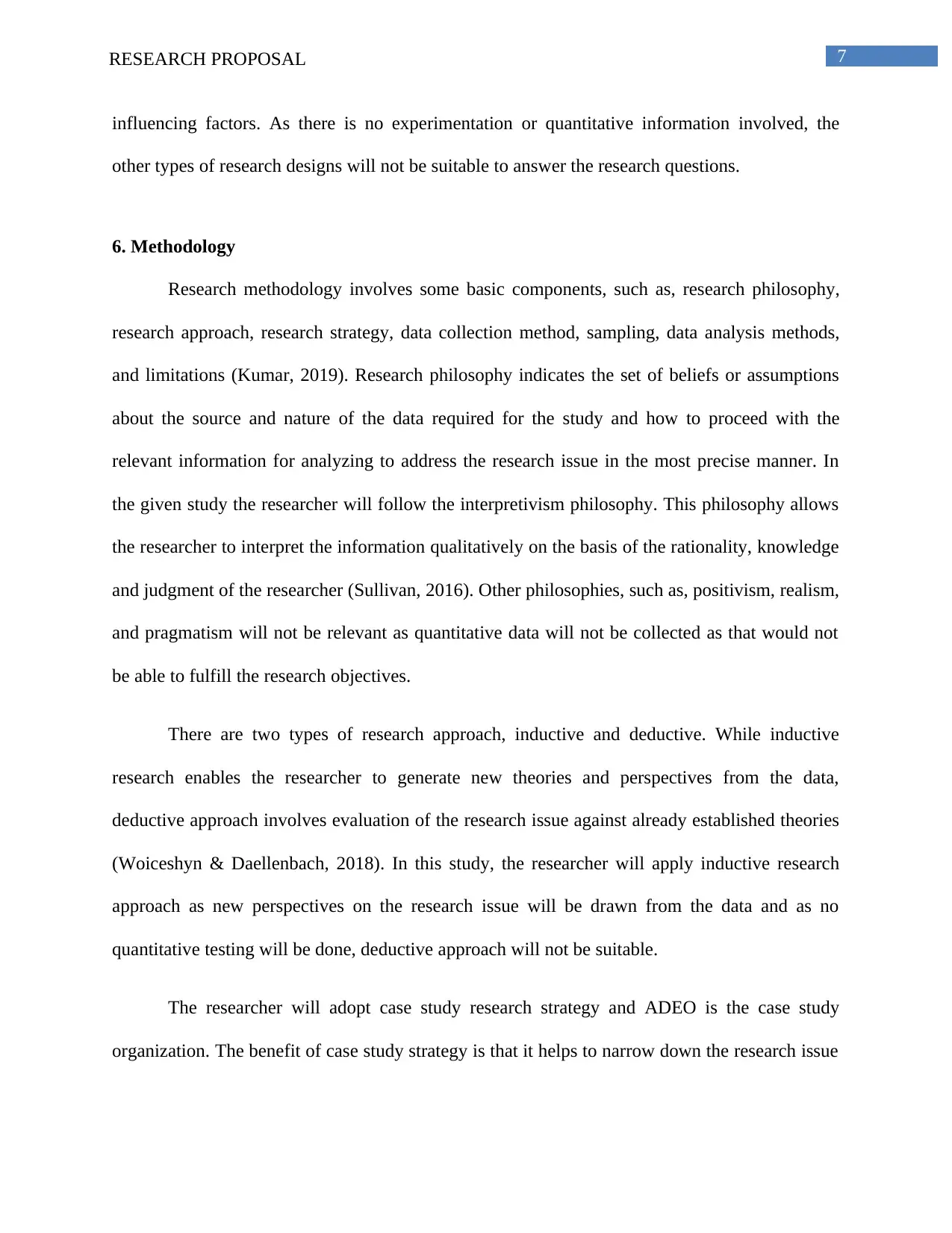
7RESEARCH PROPOSAL
influencing factors. As there is no experimentation or quantitative information involved, the
other types of research designs will not be suitable to answer the research questions.
6. Methodology
Research methodology involves some basic components, such as, research philosophy,
research approach, research strategy, data collection method, sampling, data analysis methods,
and limitations (Kumar, 2019). Research philosophy indicates the set of beliefs or assumptions
about the source and nature of the data required for the study and how to proceed with the
relevant information for analyzing to address the research issue in the most precise manner. In
the given study the researcher will follow the interpretivism philosophy. This philosophy allows
the researcher to interpret the information qualitatively on the basis of the rationality, knowledge
and judgment of the researcher (Sullivan, 2016). Other philosophies, such as, positivism, realism,
and pragmatism will not be relevant as quantitative data will not be collected as that would not
be able to fulfill the research objectives.
There are two types of research approach, inductive and deductive. While inductive
research enables the researcher to generate new theories and perspectives from the data,
deductive approach involves evaluation of the research issue against already established theories
(Woiceshyn & Daellenbach, 2018). In this study, the researcher will apply inductive research
approach as new perspectives on the research issue will be drawn from the data and as no
quantitative testing will be done, deductive approach will not be suitable.
The researcher will adopt case study research strategy and ADEO is the case study
organization. The benefit of case study strategy is that it helps to narrow down the research issue
influencing factors. As there is no experimentation or quantitative information involved, the
other types of research designs will not be suitable to answer the research questions.
6. Methodology
Research methodology involves some basic components, such as, research philosophy,
research approach, research strategy, data collection method, sampling, data analysis methods,
and limitations (Kumar, 2019). Research philosophy indicates the set of beliefs or assumptions
about the source and nature of the data required for the study and how to proceed with the
relevant information for analyzing to address the research issue in the most precise manner. In
the given study the researcher will follow the interpretivism philosophy. This philosophy allows
the researcher to interpret the information qualitatively on the basis of the rationality, knowledge
and judgment of the researcher (Sullivan, 2016). Other philosophies, such as, positivism, realism,
and pragmatism will not be relevant as quantitative data will not be collected as that would not
be able to fulfill the research objectives.
There are two types of research approach, inductive and deductive. While inductive
research enables the researcher to generate new theories and perspectives from the data,
deductive approach involves evaluation of the research issue against already established theories
(Woiceshyn & Daellenbach, 2018). In this study, the researcher will apply inductive research
approach as new perspectives on the research issue will be drawn from the data and as no
quantitative testing will be done, deductive approach will not be suitable.
The researcher will adopt case study research strategy and ADEO is the case study
organization. The benefit of case study strategy is that it helps to narrow down the research issue
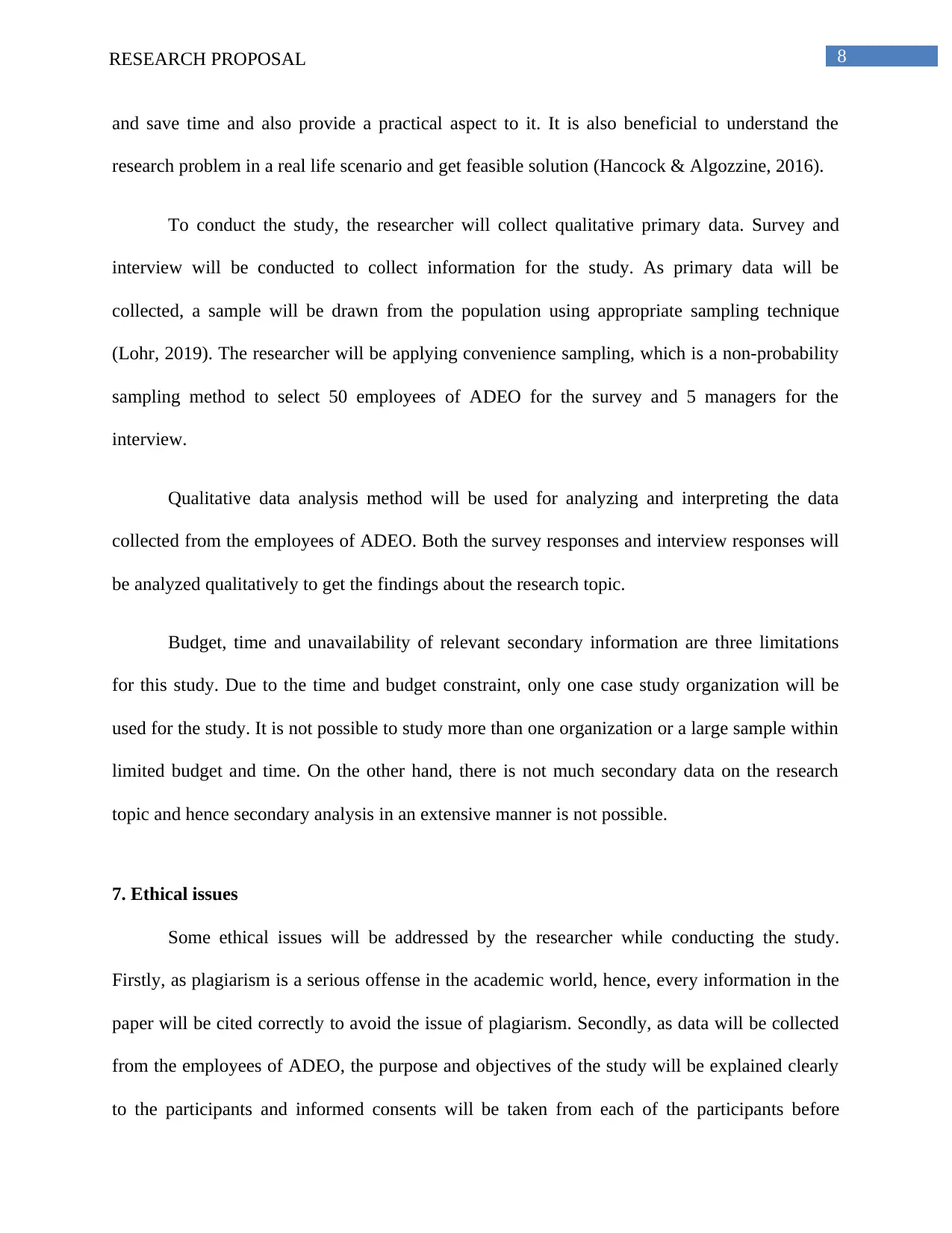
8RESEARCH PROPOSAL
and save time and also provide a practical aspect to it. It is also beneficial to understand the
research problem in a real life scenario and get feasible solution (Hancock & Algozzine, 2016).
To conduct the study, the researcher will collect qualitative primary data. Survey and
interview will be conducted to collect information for the study. As primary data will be
collected, a sample will be drawn from the population using appropriate sampling technique
(Lohr, 2019). The researcher will be applying convenience sampling, which is a non-probability
sampling method to select 50 employees of ADEO for the survey and 5 managers for the
interview.
Qualitative data analysis method will be used for analyzing and interpreting the data
collected from the employees of ADEO. Both the survey responses and interview responses will
be analyzed qualitatively to get the findings about the research topic.
Budget, time and unavailability of relevant secondary information are three limitations
for this study. Due to the time and budget constraint, only one case study organization will be
used for the study. It is not possible to study more than one organization or a large sample within
limited budget and time. On the other hand, there is not much secondary data on the research
topic and hence secondary analysis in an extensive manner is not possible.
7. Ethical issues
Some ethical issues will be addressed by the researcher while conducting the study.
Firstly, as plagiarism is a serious offense in the academic world, hence, every information in the
paper will be cited correctly to avoid the issue of plagiarism. Secondly, as data will be collected
from the employees of ADEO, the purpose and objectives of the study will be explained clearly
to the participants and informed consents will be taken from each of the participants before
and save time and also provide a practical aspect to it. It is also beneficial to understand the
research problem in a real life scenario and get feasible solution (Hancock & Algozzine, 2016).
To conduct the study, the researcher will collect qualitative primary data. Survey and
interview will be conducted to collect information for the study. As primary data will be
collected, a sample will be drawn from the population using appropriate sampling technique
(Lohr, 2019). The researcher will be applying convenience sampling, which is a non-probability
sampling method to select 50 employees of ADEO for the survey and 5 managers for the
interview.
Qualitative data analysis method will be used for analyzing and interpreting the data
collected from the employees of ADEO. Both the survey responses and interview responses will
be analyzed qualitatively to get the findings about the research topic.
Budget, time and unavailability of relevant secondary information are three limitations
for this study. Due to the time and budget constraint, only one case study organization will be
used for the study. It is not possible to study more than one organization or a large sample within
limited budget and time. On the other hand, there is not much secondary data on the research
topic and hence secondary analysis in an extensive manner is not possible.
7. Ethical issues
Some ethical issues will be addressed by the researcher while conducting the study.
Firstly, as plagiarism is a serious offense in the academic world, hence, every information in the
paper will be cited correctly to avoid the issue of plagiarism. Secondly, as data will be collected
from the employees of ADEO, the purpose and objectives of the study will be explained clearly
to the participants and informed consents will be taken from each of the participants before
⊘ This is a preview!⊘
Do you want full access?
Subscribe today to unlock all pages.

Trusted by 1+ million students worldwide
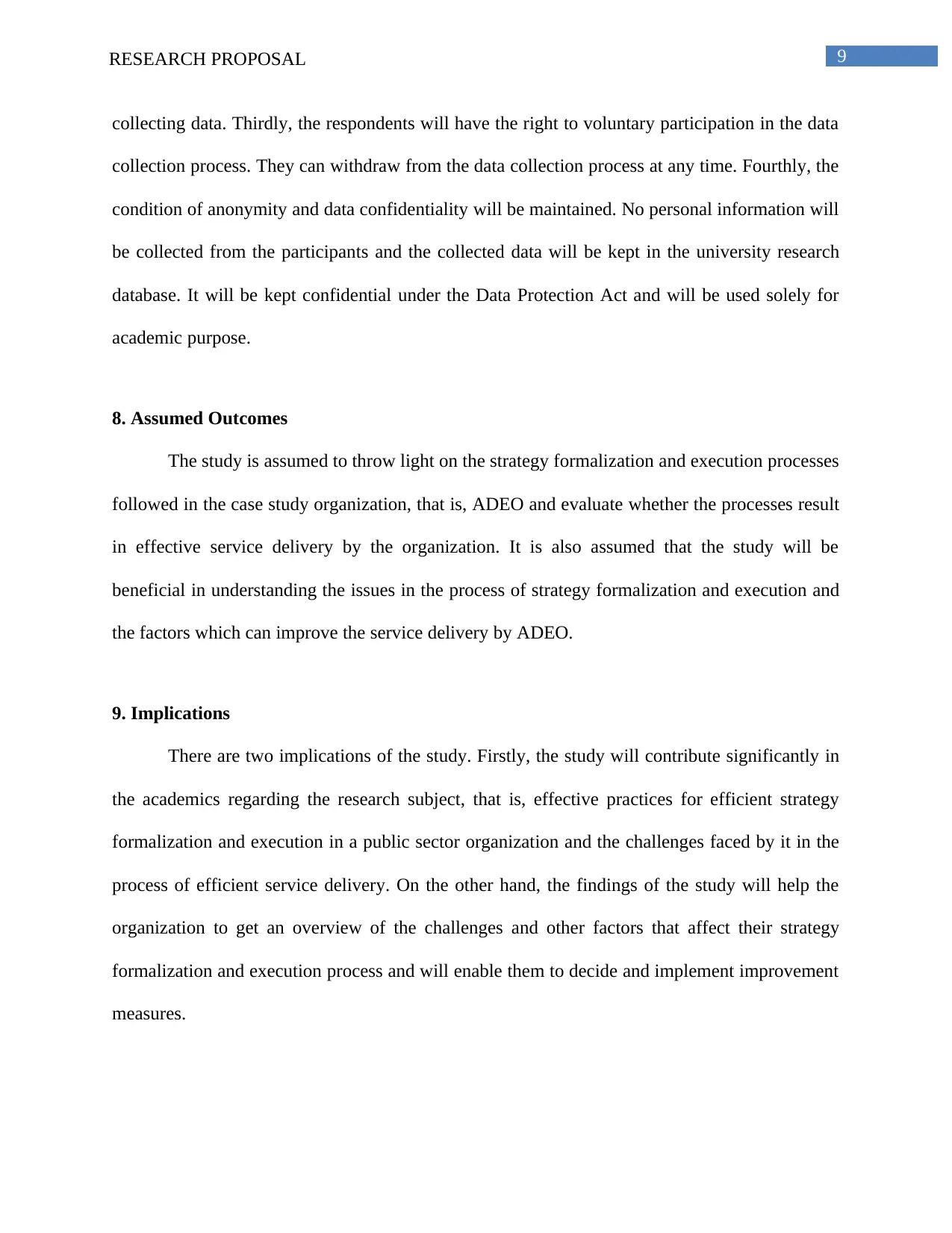
9RESEARCH PROPOSAL
collecting data. Thirdly, the respondents will have the right to voluntary participation in the data
collection process. They can withdraw from the data collection process at any time. Fourthly, the
condition of anonymity and data confidentiality will be maintained. No personal information will
be collected from the participants and the collected data will be kept in the university research
database. It will be kept confidential under the Data Protection Act and will be used solely for
academic purpose.
8. Assumed Outcomes
The study is assumed to throw light on the strategy formalization and execution processes
followed in the case study organization, that is, ADEO and evaluate whether the processes result
in effective service delivery by the organization. It is also assumed that the study will be
beneficial in understanding the issues in the process of strategy formalization and execution and
the factors which can improve the service delivery by ADEO.
9. Implications
There are two implications of the study. Firstly, the study will contribute significantly in
the academics regarding the research subject, that is, effective practices for efficient strategy
formalization and execution in a public sector organization and the challenges faced by it in the
process of efficient service delivery. On the other hand, the findings of the study will help the
organization to get an overview of the challenges and other factors that affect their strategy
formalization and execution process and will enable them to decide and implement improvement
measures.
collecting data. Thirdly, the respondents will have the right to voluntary participation in the data
collection process. They can withdraw from the data collection process at any time. Fourthly, the
condition of anonymity and data confidentiality will be maintained. No personal information will
be collected from the participants and the collected data will be kept in the university research
database. It will be kept confidential under the Data Protection Act and will be used solely for
academic purpose.
8. Assumed Outcomes
The study is assumed to throw light on the strategy formalization and execution processes
followed in the case study organization, that is, ADEO and evaluate whether the processes result
in effective service delivery by the organization. It is also assumed that the study will be
beneficial in understanding the issues in the process of strategy formalization and execution and
the factors which can improve the service delivery by ADEO.
9. Implications
There are two implications of the study. Firstly, the study will contribute significantly in
the academics regarding the research subject, that is, effective practices for efficient strategy
formalization and execution in a public sector organization and the challenges faced by it in the
process of efficient service delivery. On the other hand, the findings of the study will help the
organization to get an overview of the challenges and other factors that affect their strategy
formalization and execution process and will enable them to decide and implement improvement
measures.
Paraphrase This Document
Need a fresh take? Get an instant paraphrase of this document with our AI Paraphraser

10RESEARCH PROPOSAL
10. Expected Timescale (3 years)
Year 1 Year 2 Year 3
Task Q1 Q2 Q3 Q4 Q1 Q2 Q3 Q4 Q1 Q2 Q3 Q4
Making a strategy
Making a framework
Literature review
Primary data collection
Conducting survey
Conducting interview
Data analysis
Presenting the findings
and discussion
Providing the
conclusion
Thesis submission
10. Expected Timescale (3 years)
Year 1 Year 2 Year 3
Task Q1 Q2 Q3 Q4 Q1 Q2 Q3 Q4 Q1 Q2 Q3 Q4
Making a strategy
Making a framework
Literature review
Primary data collection
Conducting survey
Conducting interview
Data analysis
Presenting the findings
and discussion
Providing the
conclusion
Thesis submission
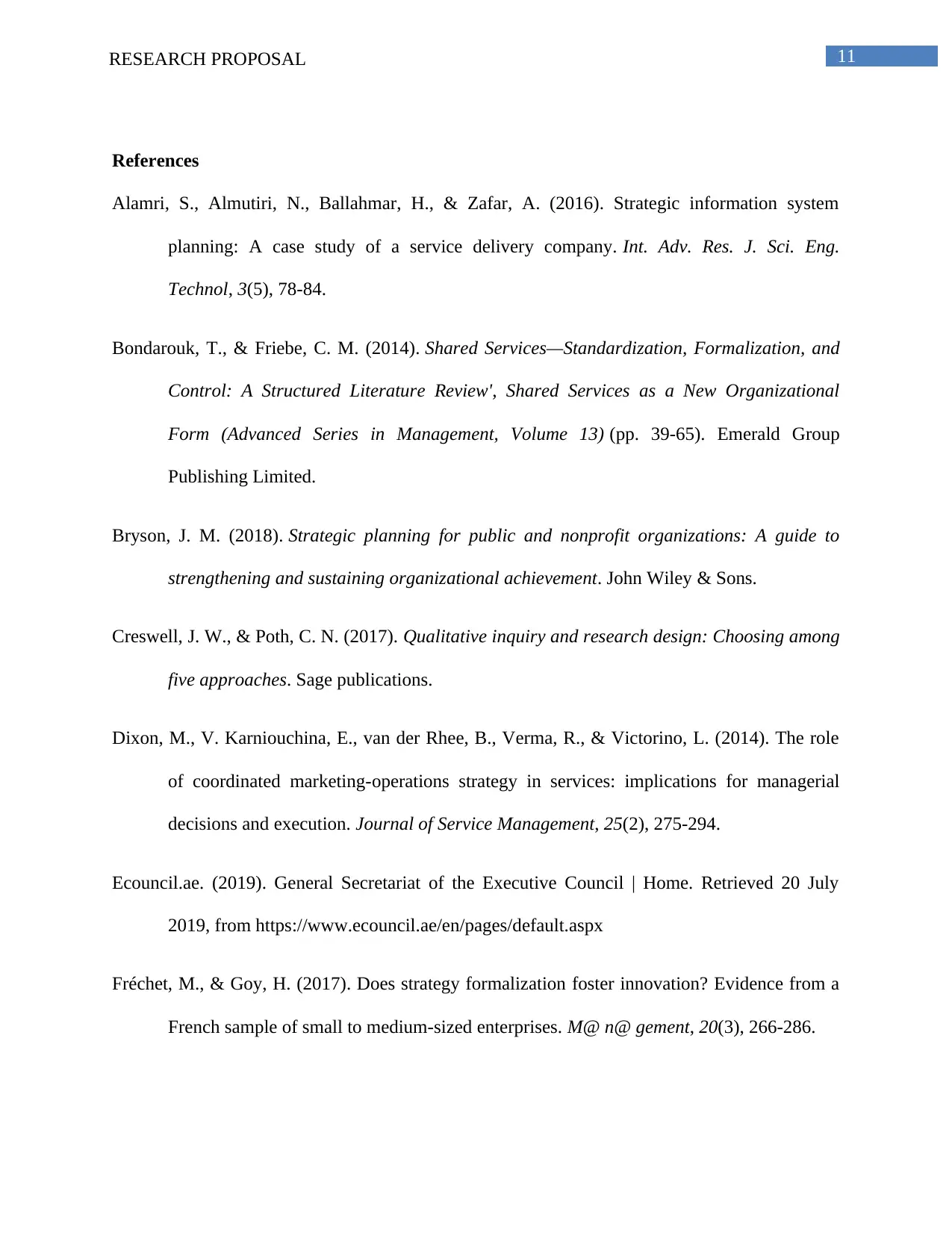
11RESEARCH PROPOSAL
References
Alamri, S., Almutiri, N., Ballahmar, H., & Zafar, A. (2016). Strategic information system
planning: A case study of a service delivery company. Int. Adv. Res. J. Sci. Eng.
Technol, 3(5), 78-84.
Bondarouk, T., & Friebe, C. M. (2014). Shared Services—Standardization, Formalization, and
Control: A Structured Literature Review', Shared Services as a New Organizational
Form (Advanced Series in Management, Volume 13) (pp. 39-65). Emerald Group
Publishing Limited.
Bryson, J. M. (2018). Strategic planning for public and nonprofit organizations: A guide to
strengthening and sustaining organizational achievement. John Wiley & Sons.
Creswell, J. W., & Poth, C. N. (2017). Qualitative inquiry and research design: Choosing among
five approaches. Sage publications.
Dixon, M., V. Karniouchina, E., van der Rhee, B., Verma, R., & Victorino, L. (2014). The role
of coordinated marketing-operations strategy in services: implications for managerial
decisions and execution. Journal of Service Management, 25(2), 275-294.
Ecouncil.ae. (2019). General Secretariat of the Executive Council | Home. Retrieved 20 July
2019, from https://www.ecouncil.ae/en/pages/default.aspx
Fréchet, M., & Goy, H. (2017). Does strategy formalization foster innovation? Evidence from a
French sample of small to medium-sized enterprises. M@ n@ gement, 20(3), 266-286.
References
Alamri, S., Almutiri, N., Ballahmar, H., & Zafar, A. (2016). Strategic information system
planning: A case study of a service delivery company. Int. Adv. Res. J. Sci. Eng.
Technol, 3(5), 78-84.
Bondarouk, T., & Friebe, C. M. (2014). Shared Services—Standardization, Formalization, and
Control: A Structured Literature Review', Shared Services as a New Organizational
Form (Advanced Series in Management, Volume 13) (pp. 39-65). Emerald Group
Publishing Limited.
Bryson, J. M. (2018). Strategic planning for public and nonprofit organizations: A guide to
strengthening and sustaining organizational achievement. John Wiley & Sons.
Creswell, J. W., & Poth, C. N. (2017). Qualitative inquiry and research design: Choosing among
five approaches. Sage publications.
Dixon, M., V. Karniouchina, E., van der Rhee, B., Verma, R., & Victorino, L. (2014). The role
of coordinated marketing-operations strategy in services: implications for managerial
decisions and execution. Journal of Service Management, 25(2), 275-294.
Ecouncil.ae. (2019). General Secretariat of the Executive Council | Home. Retrieved 20 July
2019, from https://www.ecouncil.ae/en/pages/default.aspx
Fréchet, M., & Goy, H. (2017). Does strategy formalization foster innovation? Evidence from a
French sample of small to medium-sized enterprises. M@ n@ gement, 20(3), 266-286.
⊘ This is a preview!⊘
Do you want full access?
Subscribe today to unlock all pages.

Trusted by 1+ million students worldwide
1 out of 14
Related Documents
Your All-in-One AI-Powered Toolkit for Academic Success.
+13062052269
info@desklib.com
Available 24*7 on WhatsApp / Email
![[object Object]](/_next/static/media/star-bottom.7253800d.svg)
Unlock your academic potential
Copyright © 2020–2025 A2Z Services. All Rights Reserved. Developed and managed by ZUCOL.





